Introduction
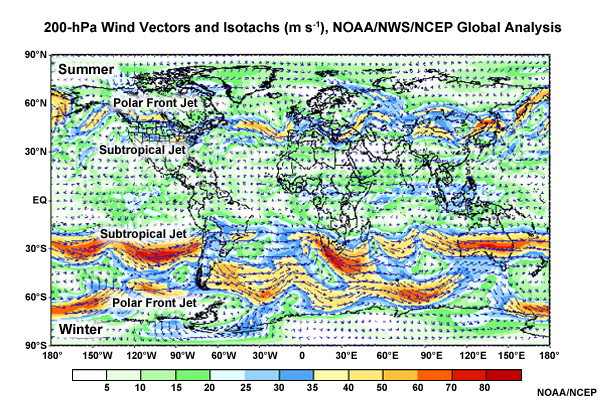
Jetstreams are intense, narrow quasi-horizontal currents of wind associated with strong vertical shear and found at or near the tropopause. A jetstream is defined by the following attributes:
- intense: at least 30 m/s for upper troposphere, at least 15 m/s for lower troposphere
- narrow: one-half to one of magnitude less in width than in length
- strong vertical wind shear: at least 5 - 10 m/s per km, one-half to one order of magnitude greater than the synoptic scale shear
A jet streak is a wind speed maximum embedded within a jet stream, like the one seen below.
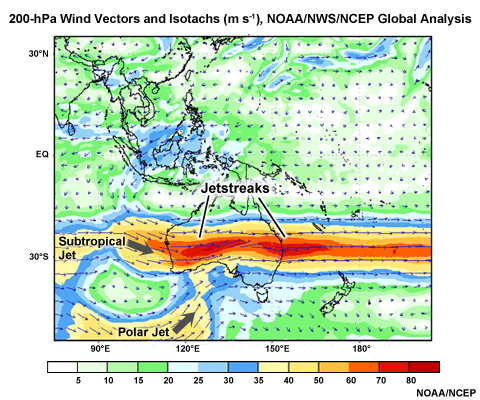
Jetstreams, as well as jet streaks, are important in synoptic and mesoscale meteorology because of their implications for upper-level divergence, and thus cyclone and precipitation development.
Upper-level divergence is proportional to both the wavelength of troughs and ridges (aka the degree of curvature) as well as to wind shear.
Divergence is maximized for an upper-level wave with the following characteristics:
- large amplitude
- short wavelength
- strong wind speed and wind shear (which are a function of the horizontal thermal gradient at lower levels - the greater this baroclinicity, the greater the upper level divergence)
To understand upper-level divergence we can analyze processes in terms of the expanded ageostrophic wind equation:

Term A is the isallobaric wind, Term B is the inertial-advective wind, and Term C is the inertial-convective wind. Here we will focus mainly on the inertial-advective wind in Term B, but for a full explanation of all terms you can view the entire module on jet streak circulations at https://www.meted.ucar.edu/training_module.php?id=166#.VgWULctVhBc
The inertial-convective wind in term B has the following characteristics:
- strongest where there are changes in wind speed or direction downstream
- “points” upstream in cyclonically curved flow and downstream in anticyclonically curved flow
- “points” to the left of the flow (in NH, as are all examples herein) if speed increases downstream, and to the right if speeds decrease downstream.
Thus, on an upper-level plan view the ageostrophic vectors would look something like this for a general trough/ridge system:
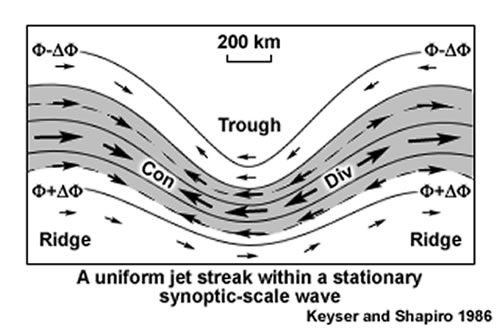
We can immediately see that the ageostrophic wind has the greatest magnitude in the base of the trough, where the jet is strong and curvature is strongest.
We can also notice that the vectors point upstream within the cyclonically curved area and downstream within the anticyclonically curved areas. This creates convergence of ageostrophic motion to the west of the trough axis and divergence east of it. This is simply a reflection of supergeostrophic vs subgeostrophic flow from gradient wind theory.
The next component to consider is rapid changes in speed - jet streaks.
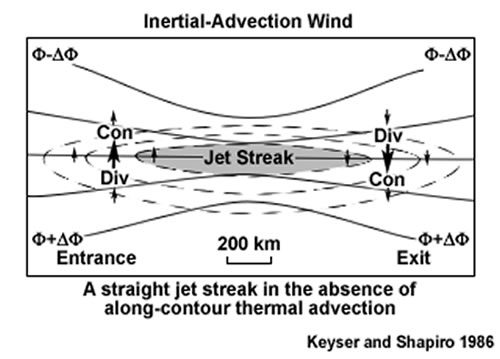
In this straight jet streak, we can see that the ageostrophic vectors point to the left of the flow where speeds increase downstream (in the “entrance” region of the jet streak, or where the jet streak begins in a flow-relative sense). The vectors point to the right of the flow in the exit region, where speed decreases downstream. Thus, we have divergence in the right entrance and left exit regions of the jet streak, and convergence in the left entrance and right exit regions.
Some good further discussion of the inertial-advective wind can be found in chapter 2 of Lackmann's Midlatitude Synoptic Meteorology or chapter 6 of Martin's Mid-latitude Atmospheric Dynamics.
The upper level divergence and convergence due to curvature and jet streaks mentioned here aid with ascent and descent, respectively.
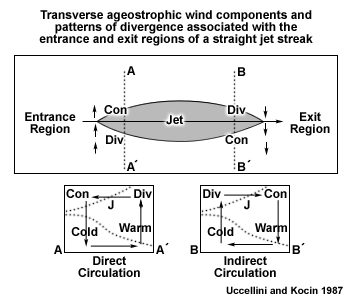
Above is a conceptual model of the thermally direct and indirect circulations induced by the upper-level convergence and divergence in the streak region. In the entrance region, divergence on the right side induces ascent of warm air south of the jet, and this air moves northward where convergence forces it to descend below the left entrance region (see cross section A to A'). In the exit region, a circulation develops in the opposite sense, both in direction and in terms of thermal structure - the cool air from the north side of the jet is ascending.
This is the most basic conceptual model to illustrate jet streak circulations. In reality, jet streaks rarely occur in a uniform, zonal manner as above, and the vertical portions of the transverse circulations are much more gently sloping.
Here's a more realistic view of jet streak circulations, in which flow is induced along sloped isentropic surfaces (ignoring diabatic heating) toward the divergent regions.
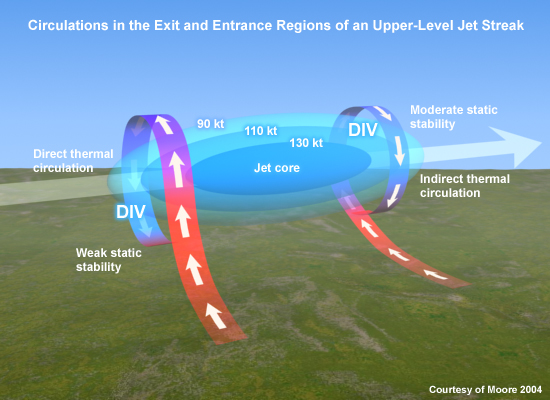
Here we can see that each side of the jet streak can induce strong southerly flow at low levels. Additionally, a northerly low-level jet of sorts can be induced in the left entrance region. This can make the entrance region a favored area of heavy snow development in winter months.
Overall, the strength of these circulations will depend upon the shape and position of the jet streak within the overall curvature of the jetstream - in many cases, the effects of curvature dominate the streak circulations, as is the case with the rarely observed “jet streak in the base of the trough”. We'll now analyze some examples.